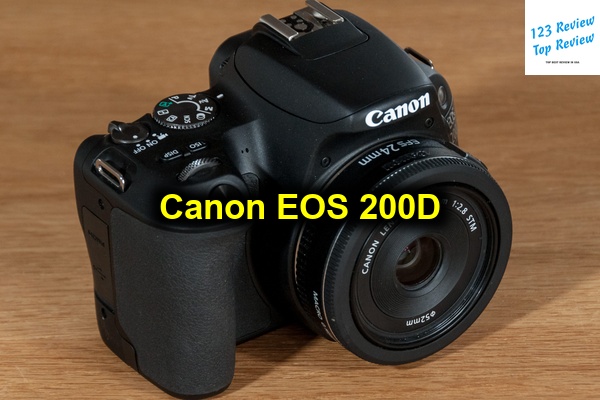The Canon EOS 200D, also marketed as the Rebel SL2 in some regions, has cemented its place as a beloved option among entry-level DSLR enthusiasts seeking a compact and versatile camera. This model builds upon the success of its predecessor, the EOS 100D, by integrating improved image processing, advanced autofocus technology, and enhanced video capabilities.

In this article, 123 Review explores the Canon EOS 200D in detail, examining its features, strengths, and how it compares within its category.
Performance and Image Quality
24.2 Megapixel APS-C Sensor
One of the standout features of the Canon EOS 200D is its 24.2-megapixel APS-C CMOS sensor. The APS-C format is a widely adopted standard in DSLRs, offering an excellent compromise between sensitivity and depth of field. This sensor size is particularly suitable for a variety of photographic scenarios, including portrait, landscape, and street photography, where detail and clarity are paramount.
The 24.2 MP resolution provides ample room for creative cropping, enabling photographers to maintain high-quality images even when trimming down to specific subjects or framing. This capacity is crucial for photographers seeking flexibility without compromising the visual integrity of their shots. The sensor’s design also plays a significant role in delivering superior dynamic range, which manifests in rich detail retention from shadows to highlights—a key feature for those capturing scenes with challenging lighting contrasts.
DIGIC 7 Image Processor
Driving the performance of this sensor is Canon’s DIGIC 7 image processor. As an upgrade from previous models, the DIGIC 7 enhances the camera’s overall speed, efficiency, and image processing capabilities. This results in faster shooting speeds, improved noise reduction algorithms, and superior handling of high ISO settings, helping photographers to push boundaries in low-light environments.
The processor’s contribution extends beyond speed and noise control; it also supports a wider range of customizable settings, catering to photographers who desire greater artistic control over their images. The combination of the DIGIC 7 processor and the APS-C sensor ensures that the Canon EOS 200D delivers crisp, high-resolution photos with accurate colors and minimal artifacting.
ISO Range and Low Light Performance
Offering an ISO range of 100-25,600, expandable to 51,200, the EOS 200D is well-prepared to handle a spectrum of lighting conditions. This expansive range allows photographers to capture images in bright daylight or dimly lit environments without significant degradation in quality. In practical terms, the camera performs impressively up to an ISO of 3200, maintaining clear images with minimal noise. Beyond this, noise becomes more noticeable, but remains manageable with post-processing.
This wide ISO range, coupled with the powerful DIGIC 7 processor, makes the EOS 200D a versatile tool for low-light photography, supporting night street scenes, indoor events, and other challenging light conditions. Photographers can shoot with confidence, knowing that image stabilization and noise reductions are working in tandem to deliver quality results.
Burst Shooting Capabilities
The EOS 200D offers a continuous shooting speed of 5 frames per second (fps). While not the fastest in its class, this rate is sufficient for capturing moderate action scenes, such as children at play or simple nature movements. The burst mode offers photographers the ability to freeze moments in time, increasing the likelihood of capturing the perfect shot during a brief event.
Although sports and wildlife enthusiasts might seek faster burst rates found in higher-tier models, the speed provided by the EOS 200D is ample for general use. The buffer depth allows for around 11 RAW images and 30 JPEG images, enabling photographers to work efficiently without frequent interruptions.
Autofocus System
Dual Pixel CMOS AF Technology
An innovation introduced by Canon, the Dual Pixel CMOS AF technology is a standout feature of the EOS 200D. This system revolutionizes autofocus by allowing each pixel to function as a phase-detection point. Consequently, Dual Pixel AF delivers swift, smooth, and accurate autofocus performance not only during still shooting but also when recording video.
This technology shines in scenarios requiring fast adjustments, such as tracking moving subjects or refocusing during video capture. This autofocus system significantly enhances usability, making it easier for photographers of all skill levels to achieve professional-looking results. Dual Pixel AF is particularly advantageous for vloggers or video producers, as it ensures that subjects remain in focus with minimal manual adjustments.
Autofocus Points and Performance
While the camera features only 9 autofocus points, which includes one cross-type point at the center, the configuration remains competitive for its class. The cross-type point enhances focusing accuracy in challenging conditions, such as low contrast or low light. Although this may seem limited compared to cameras with more points, the EOS 200D compensates with the precision and speed provided by Dual Pixel technology.
The focus points are effective for typical entry-level uses, including portraits, landscapes, and casual action photography. The camera’s autofocus capabilities are further supported by Canon’s AI Servo mode, which continues to track moving subjects across the 9 points, providing consistent and reliable performance.
Live View vs. Viewfinder Autofocus
A significant advantage of the EOS 200D is its use of Dual Pixel AF in Live View mode, where it offers far superior performance compared to the traditional viewfinder autofocus. Using the optical viewfinder, autofocus can be slower, especially in less-than-ideal lighting conditions. However, the Live View, aided by the articulated touchscreen, brings a modern touch to focusing, enabling photographers to touch to focus and shoot rapidly.
The Live View mode stands out for close-ups or when precise control over depth of field is needed, allowing photographers to benefit from Dual Pixel AF’s full potential. This seamless transition between Live View and traditional viewfinder shooting provides flexibility, catering to varied shooting preferences and scenarios.
Video Capabilities
1080p Video Quality
The Canon EOS 200D offers robust video recording capabilities, capturing 1080p Full HD video at up to 60 frames per second. This quality is sufficient for most casual and semi-professional applications, providing videographers with crisp, detailed footage. The camera supports easy frame rate adjustments, granting creative options for slow-motion shots or speeding up scenes for dynamic storytelling.
The video quality is further enhanced by Canon’s color science, which renders natural skin tones and vibrant color reproduction. These elements combine to produce professional-looking videos directly from the camera, minimizing the need for extensive post-production adjustments.
Video Autofocus Performance
Harnessing the power of Dual Pixel CMOS technology, the EOS 200D excels in continuous autofocus during video recording. This capability ensures that subjects remain sharp and well-defined, even as they move within the frame. Filmmakers can shift focus smoothly and naturally, mimicking professional filming techniques with ease.
This feature is particularly beneficial for vloggers and documentary filmmakers, as it reduces the likelihood of blurred footage due to out-of-focus subjects. The camera’s face detection and tracking capabilities add an extra layer of reliability, maintaining focus on individuals as they navigate the scene.
Lack of 4K Video and Frame Rate Options
One notable limitation of the EOS 200D is the absence of 4K video recording, a feature that has become a standard in modern cameras, even at the entry-level. While 1080p encompasses the needs of many users, the lack of 4K could be a deal-breaker for those seeking the maximum resolution and future-proof content creation.
Moreover, the frame rate options are somewhat restricted, limiting resourceful manipulations such as ultra slow-motion. These omissions could influence photographers and videographers aspiring to integrate high-definition video into their portfolios, prompting them to consider models offering these capabilities.
Design and Usability
Compact Size and Weight
One of the outstanding characteristics of the Canon EOS 200D is its compact size and lightweight body, weighing approximately 453 grams with battery and memory card included. This makes it one of the most portable DSLRs available, ideal for photographers who prioritize mobility.
Its small form factor does not compromise build quality—design materials ensure a robust feel, able to withstand the rigors of travel photography. The blend of size, weight, and durability makes the EOS 200D a fantastic choice for travelers, street photographers, and anyone requiring a camera that is easy to carry throughout lengthy sessions.
Articulated Touchscreen Benefits
The 3-inch vari-angle LCD touchscreen is a notable highlight, offering full articulation for dynamic shooting angles. This feature significantly extends the creative possibilities for photographers, facilitating comfortable compositions whether shooting from above, below, or even around corners.
Touchscreen functionality adds an element of convenience, enabling swift navigation through menus and settings changes. Users can intuitively adjust the focus and review photos, akin to smartphone experiences, which is particularly useful for beginners and those accustomed to touchscreen interfaces.
Control Layout and Accessibility
The EOS 200D’s layout underscores Canon’s commitment to intuitive design, with clearly labeled buttons and an accessible control scheme tailored for ease of use. The controls, while straightforward for novices, remain functional for more advanced users, ensuring no compromise on accessibility or performance tweaks.
The camera features a dedicated mode dial, quick control dial, and a straightforward interface that allows photographers to access and adjust settings with minimal interruption instantly. These elements, coupled with the ergonomic grip, provide a seamless interaction, allowing users to adapt quickly to different shooting requirements.
Connectivity and Features
Wireless Options: Wi-Fi, Bluetooth, NFC
The Canon EOS 200D is outfitted with a robust array of connectivity options, including Wi-Fi, Bluetooth, and NFC. These features facilitate easy sharing and transferring of images to compatible devices, enhancing the photographer’s ability to upload and share their work instantly.
Wi-Fi enables direct connection to smartphones, tablets, and even printers, allowing for seamless image transfer and remote shooting capabilities. Bluetooth offers a low-energy connection option, facilitating constant connectivity to a paired device, which is excellent for geotagging photos or transferring smaller resolution files quickly. NFC simplifies initial pairing with compatible smartphones or tablets, streamlining the setup process.
Remote Shooting and App Integration
The integration with Canon’s Camera Connect app is another commendable feature, unlocking further functionality like remote shooting. This proves advantageous for group shots, self-portraits, or wildlife photography, where it’s impractical to remain next to the camera.
The app offers comprehensive control over camera settings, enabling photographers to adjust exposure, focus, and even shutter speed from their mobile device. This integration expands the camera’s versatility, allowing creative executions without physical limitation to the camera body itself.
Comparison with Other Models
Canon EOS 800D Comparison
When placed alongside the EOS 800D, a similarly positioned model, several differences stand out. The Canon EOS 800D features a more advanced 45-point all cross-type autofocus system, giving it an edge in terms of coverage and focusing accuracy, particularly beneficial for fast-moving subjects or in scenarios with complex compositions.
In terms of burst speed, the 800D also offers a slight increase, delivering 6 fps compared to the 200D’s 5 fps. These enhancements, coupled with additional creative filters and guide modes, cater to photographers seeking a little more from their entry-level DSLR, though it comes at a slightly higher price point.
Entry-Level Competitors: Nikon D3400
When comparing the Canon EOS 200D to competitors like the Nikon D3400, it presents compelling features such as the touchscreen interface and Dual Pixel AF, which are not present in the Nikon counterpart. Although the D3400 offers exceptional battery life, often extending well over 1000 shots per charge, it lacks the advanced AF system and user-friendly touchscreen that enhance the 200D’s appeal.
The Nikon does deliver excellent image quality through its own 24.2 MP sensor, but Canon’s enhanced focusing system and video capabilities mark significant delineations between the two models, catering better to a modern, multimedia-loving audience.
Mirrorless Alternatives
In the increasing shift towards mirrorless, cameras like the Canon EOS M50 present strong competition. The M50 offers 4K video capabilities, a compact form, and a comprehensive autofocus system with more points. However, this comes with certain drawbacks, such as reduced battery life compared to DSLRs and sometimes less ergonomic handling.
For users who prioritize cutting-edge video and lighter build, mirrorless alternatives provide an attractive proposition. Yet, the traditional DSLR experience and superior battery durability of the 200D continue to appeal to those valuing extended shooting sessions and conventional camera operation.
Conclusion and Recommendations
Target Audience for Canon EOS 200D
Designed with novices and hobbyists in mind, the Canon EOS 200D is perfect for anyone stepping into the realm of DSLR photography. It stands out due to its combination of compact size, intuitive usability, and solid feature set. The camera is tailor-made for individuals desiring a lightweight option without sacrificing quality or performance.
Best Use Cases for the Camera
With its combination of features, the EOS 200D is a versatile tool suited for travel, street photography, family events, and vlogging. Its compact nature makes it a wonderful companion for travel enthusiasts capturing journeys without cumbersome equipment, and its efficient user interface attracts photographers wishing to learn and grow in their craft.
Overall, the Canon EOS 200D shines as a robust, user-friendly entry-level DSLR, offering a blend of solid performance, portability, and connectivity that is difficult to beat within its price and class spectrum. Aspiring photographers looking for an all-rounded camera to develop their skills will find the EOS 200D a worthy investment.





